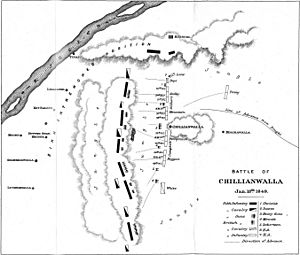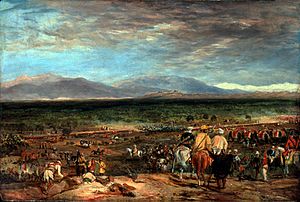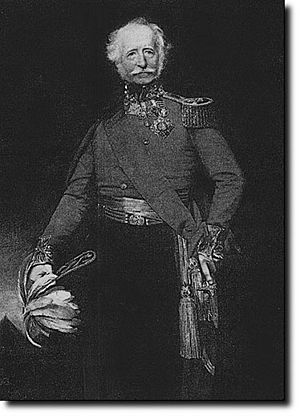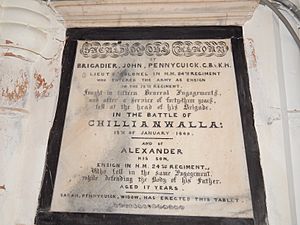Battle of Chillianwala facts for kids
Quick facts for kids Battle of Chillianwala |
|||||||
|---|---|---|---|---|---|---|---|
| Part of the Second Anglo-Sikh War | |||||||
 Map of the battle |
|||||||
|
|||||||
| Belligerents | |||||||
| Commanders and leaders | |||||||
| Sir Hugh Gough | Raja Sher Singh Attariwalla | ||||||
| Strength | |||||||
| 15,000 100 guns |
10,000-13,000 60 guns |
||||||
| Casualties and losses | |||||||
| 2,512 (~1,512 Indian, ~1,000 British) | Unknown | ||||||
The Battle of Chillianwala was a major fight during the Second Anglo-Sikh War. It happened in January 1849 in the Chillianwala area of Punjab. This region is now part of modern-day Pakistan. This battle was one of the bloodiest for the British East India Company. Both armies stayed in their positions when the battle ended. Both sides also said they had won. The battle was a big challenge to British plans in India. It also surprised many people about the strength of the British army.
Contents
Why the Battle Happened
The Second Anglo-Sikh War started in Punjab in April 1848. Punjab had recently lost much of its freedom to the British East India Company. This happened after the First Anglo-Sikh War. The new war began when the city of Multan rebelled under Dewan Mulraj.
The British East India Company was a powerful trading company that also had its own army. Their leader in Punjab, Frederick Currie, sent troops to stop the rebellion. One group of these troops was made up of Sikhs. They were led by Sher Singh Attariwalla. Some British officers were worried because Sher Singh's father, Chattar Singh Attariwalla, was planning to rebel in Hazara.
On September 14, Sher Singh's army also rebelled. Sher Singh and Mulraj did not have the same goals, except that they both opposed the British. Sher Singh decided to move his army north to join his father, Chattar Singh. But some British officers had taken control of important forts. So, Chattar Singh could not leave Hazara for a while. Sher Singh then moved a few miles north. He made his positions strong near the Chenab River while waiting.
The British East India Company reacted by saying they would remove the young king, Duleep Singh. They also planned to take over Punjab. They would take away the land of anyone who joined the rebellion. While one army started to attack Multan again, the Company formed a new army. This "Army of the Punjab" was led by the experienced commander, Sir Hugh Gough. However, Gough and the Governor General, Lord Dalhousie, waited until after the rainy season. This gave Sher Singh time to get more soldiers and build strong defenses.
Gough took charge of his army on November 21. The next day, he attacked Sher Singh's position at Ramnagar. But he was pushed back, which made the Sikh soldiers feel more confident. On December 1, a group of cavalry crossed the Chenab River. Sher Singh moved to fight them, leading to a day-long artillery battle. Gough then stopped, waiting for more orders.
In January 1849, the British heard that Multan city had been taken back. But they also learned that the fort of Attock had joined forces with Dost Mohammad Khan of Afghanistan. This allowed Chattar Singh's army to leave Hazara and move south. Lord Dalhousie ordered Gough to find and defeat Sher Singh's main army quickly. He wanted this done before the two Sikh armies could join together.
The Armies Meet
On January 13, Gough's army was marching towards the Sikh position at Rasul. This was near the Jhelum River. Around noon, they pushed a Sikh outpost out of the village of Chillianwala. Gough had planned to march around the Sikh position and attack their left side the next day. But from a hill near Chillianwala, it was clear the Sikhs had moved forward. They were now on ridges closer to the Jhelum.
Sher Singh's army had first spread out over six miles. This was too long for their number of soldiers. It also made them open to a side attack. By moving forward, Sher Singh made a British side attack too risky. He forced the British to attack from the front.
British officers thought Sher Singh's army had about 23,000 soldiers. This included 5,000 irregular cavalry and about 60 guns. However, after the First Anglo-Sikh War, the Sikh army was smaller. Some historians believe the Sikh army had no more than 10,000 soldiers that day.
The Sikh army had three main groups of troops. On the left, Sher Singh himself led cavalry, infantry, and 20 guns. In the middle, Lal Singh led cavalry, infantry, and 17 guns. These were hidden in bushes and jungle. On the right was a group from Bannu, with cavalry, infantry, and eleven guns. Other irregular soldiers were on Sher Singh's far left side.
Gough wanted to wait until the next day to attack. But as his army got ready to set up camp, hidden Sikh cannons started firing. They were much closer than expected. Gough later wrote that he feared the Sikhs would bomb his camp all night. Some of his officers thought he just acted too quickly.
Gough's army had two main groups of infantry. Each group had one British and two Indian battalions. They had 66 guns in total. The 3rd group was on the left, and the 2nd group was on the right. Gough also had a cavalry group, split into two parts. Two heavy artillery batteries were in the center. A group of Indian troops was kept in reserve.
The Battle Begins
Gough ordered his army to advance around 3:00 PM. From the very start, the right side of Campbell's division faced problems. This group was led by Brigadier Pennycuick. The jungle made it hard for Campbell to control his two groups. He took charge of the left group himself. He told Pennycuick to attack with bayonets.
Pennycuick's British regiment, the 24th Foot, had just arrived in India. They moved very fast. But they lost their formation and got separated from the rest of their group in the thick bushes. They tried to attack Sikh guns directly. They suffered many losses from grapeshot (small metal balls fired from cannons). When they reached the main Sikh positions, the Sikhs fought very hard. The 24th Foot was pushed back. Their flag was lost, but the Sikhs never said they captured it. It was likely destroyed or buried with the officer who carried it. Pennycuick's group became completely disorganized. They had to return to their starting point in small groups. Pennycuick himself was killed.
Campbell's left group had more success. The 61st Foot captured several guns and even an elephant. The cavalry followed up with a strong charge. These troops eventually met another British group behind the Sikh center.
However, on Gough's right side, his troops faced disaster. Gilbert's two groups at first pushed the Sikhs back. They captured many guns. But on their right side, Brigadier Pope (who was not well) made mistakes. He ordered a cavalry charge through thorny bushes, which confused his soldiers. Then he panicked and ordered a retreat. One of his British cavalry groups, the 14th Light Dragoons, ran away. The Sikhs chased the fleeing cavalry and captured four guns. They then attacked Gilbert's right-hand infantry group from behind. This forced them to pull back until Penney's reserve group came to help.
By this time, it was getting dark. The Sikhs had been pushed out of many of their positions. They had many casualties. But they were still fighting strongly. Some of Gough's groups were not effective, or had to fight their way out of being surrounded. So, Gough ordered a retreat back to the starting line. His soldiers carried back as many wounded as they could. But many could not be found in the bushes. Many wounded soldiers who were left behind were killed during the night by Sikh irregulars. Gough's retreat also allowed the Sikhs to get back almost all the guns the British had taken earlier.
Who Won and What Happened Next
Both armies stayed in their positions at the end of the battle. Both sides said they had won. Heavy rain started, which stopped both armies from fighting again. Some of Chattar Singh's army joined Sher Singh. The British had wanted to stop these two Sikh armies from joining. So, this was a clear setback for the British. The British pulled back three days after the battle. The Sikhs said they forced the British to retreat. But Gough had actually pulled back because of the rain. However, the Sikhs could not find enough food in the area. So Sher Singh, who led the combined Sikh armies, also pulled back north.
Since the Sikhs left first, the British claimed victory. But they admitted that the Sikhs missed a chance to win. The British were pushed back. They lost several guns and the flags of three regiments. One cavalry group also ran away. This hurt British morale. It also showed how tough and skilled the Sikh army was.
A British observer said: "The Sikhs fought like devils, fierce and untamed... Such a mass of men I never set eyes on and a plucky as lions: they ran right on the bayonets and struck their assailants when they were transfixed."
Major A.H. Amin, a military historian, later wrote that at Chillianwala, the British army failed to defeat the Sikhs. This was despite having many European troops, many Indian soldiers, enough cannons, and good supplies.
Gough was criticized for how he handled the battle. He was removed from command. General Charles James Napier was sent to replace him. But before Napier could arrive from England, Gough fought another important battle. This was the decisive Battle of Goojerat.
The loss of British pride at Chillianwala was one reason for the Indian rebellion of 1857 nine years later. However, Sikh soldiers who joined the British East India Company's army stayed loyal to Britain. They helped to stop that rebellion.
The Battle of Chillianwala also influenced later events. For example, the Namdhari Revolt of 1871. Ram Kuka often spoke about the battle.
Within the British Army, the events at Chillianwala caused much worry. Later, after the disastrous Charge of the Light Brigade, a general said, "These sort of things will happen in war. It is nothing to Chillianwala." This shows how shocking Chillianwala was to them.
British and Indian Army Regiments
Here are some of the regiments that fought for the British and the East India Company:
British Regiments
- 3rd King’s Own Light Dragoons
- 9th Queen’s Royal Light Dragoons (Lancers)
- 14th the King’s Light Dragoons
- 24th Foot
- 29th Foot
- 61st Foot
British Indian Army Regiments
- 1st Bengal Light Cavalry
- 5th Bengal Light Cavalry
- 6th Bengal Light Cavalry
- 9th Bengal Light Cavalry
- 2nd Bengal (European) Light Infantry
- 6th Bengal Native Infantry
- 15th Bengal Native Infantry
- 20th Bengal Native Infantry
- 25th Bengal Native Infantry
- 30th Bengal Native Infantry
- 31st Bengal Native Infantry
- 36th Bengal Native Infantry
- 45th Bengal Native Infantry
- 46th Bengal Native Infantry
- 56th Bengal Native Infantry
- 69th Bengal Native Infantry
- 70th Bengal Native Infantry
Images for kids








